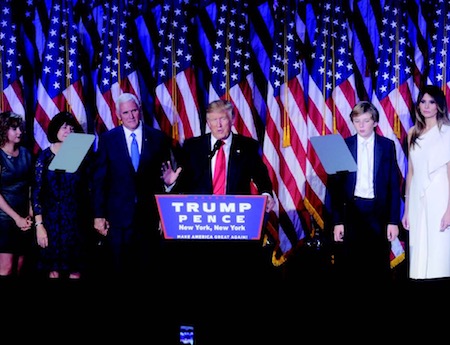TV News Didn’t Dress for Success With Big Whiff on Trump

America's television networks missed the memo about Election Night’s dress code. They took to the airwaves dressed all to the nines with splashy, data-driven sets and phalanxes of pundits. Their decked-out successors to Cronkite’s throne stood ready to reassure viewers that the threat of a Donald Trump presidency had been quelled, that Hillary Clinton had prevailed just as they had predicted.
Then, all around them, it turned out to be a sea of blue jeans and flannel and America was firing up the barbeque. Precincts expected to be blue came up red, and the narrative that pollsters and purveyors of conventional wisdom had crafted turned out to be utterly false. The night they expected to be an historic coronation of the first female president turned into a night of soul-searching that has still not come to an end.
So what in the name of Howard Beale happened? Politically, at least, the outcome has logic to it. Trump successfully channeled the anger and disillusionment of many Americans, especially white, working-class voters. Contradicting polls, Republicans—notably college-educated women—held their noses and backed their party’s nominee. Democrats, meanwhile, did not turn out in force, and Clinton’s opaque messages eluded crucial states like Florida, Wisconsin and Pennsylvania. She captured the popular vote, but for only the fifth time since the Electoral College was established in 1787, the other nominee reached the White House due to college math.
The media story is different. Trump has always been a media phenomenon, given that he has never held elected office and rose to prominence thanks to an NBC reality show and decades of appearances on Howard Stern and Page Six. But once he declared his candidacy in mid-2015, an odd dance began, particularly with TV networks. NBC, despite efforts by executives to declare distance from their former Apprentice star, invited him to host Saturday Night Live and raised hackles with late-night host Jimmy Fallon’s hair-tousling and Matt Lauer’s kid-gloves moderating of a made-for-TV forum.
When networks weren’t inviting criticism with kid-gloves treatment, they were making it too easy for his campaign to declare mainstream media their enemy. (That reflex continued even post-election, with Trump tweeting blame for the media after protests against his win). One popular chant at rallies was a more profane version of “Toss CNN!” On ABC, George Stephanopoulos offered red meat to those chanters when he disclosed donations to the Clinton Foundation and the network scrambled to reshuffle on-air duties. Even Fox News faced an identity crisis as word got out that Rupert Murdoch himself wasn’t a Trump supporter. The network became strangely bifurcated, with Sean Hannity and Bill O’Reilly championing Trump while Megyn Kelly and others openly questioned the nominee. That schism played out on Election Night. Karl Rove—the personification of the network’s lockstep talking-points role in the George W. Bush years—departed from his Mitt-Romney-could-still-take-Ohio act of 2012. “This country has survived elections before in which there was bitterness,” he shrugged, mirroring the resigned sentiments of many leftwing analysts.
The Atlantic’s Salena Zito offered a warning in September that went un-heeded. The media, she wrote, “takes Trump literally, but not seriously; his supporters take him seriously, but not literally.” Print and digital outlets are beating themselves up, but the Washington Post, the Associated Press and The New York Times did explore Trump Country, exposing the nominee’s flaws and scrutinizing his base.
The same cannot be said of TV news. Cable networks reaped ratings from phony primary debates, rallies, and fixated on soap opera and spectacle. Broadcast news divisions, with the exception of some digging by 60 Minutes and a few others, succumbed to their current mandate, which favors entertainment, clickability and synergy over shoe leather. One veteran of both cable and broadcast, Brian Williams, decried “Margaret Mead journalism” during his MSNBC stint on Election Night. He marveled at the moment “when New York- and Washington-based journalists either accidentally take the wrong turn on GPS and drive into America, or drive through America to visit a relative, come back and report, ‘The place is covered with Trump signs!’”
Broadcasting & Cable Newsletter
The smarter way to stay on top of broadcasting and cable industry. Sign up below
The other major lesson from 2016 is the addiction to polls. Entranced by the social-media might of sites like 538, which Disney/ESPN gobbled up in 2014, networks all overdosed on data, or at least didn’t marry it with enough perspective from the field. While some, notably CNN’s John King, proved nimble quants as the pro Clinton polling unraveled, the notion of pinning so much on such dubious data now seems almost laughable.
Yet knowing all of this, how will networks whose staffs have thinned and who rely on armchair tools like social media deploy actual boots on the ground? Plus, beyond the question of resources, the great unknown is access. As Omarosa Manigault, the Apprentice-villain-turned-Trump-surrogate, put it, “Mr. Trump has a long memory and we’re keeping a list.” With loyalists like ex-Breitbart chief Steve Bannon, Corey Lewandowski and Newt Gingrich likely running the Administration, it may be harder than ever to get a feel for Trump’s America. And the only thing more embarrassing for TV news than its Election Night Waterloo could be spending four years with its nose pressed up against the glass.










